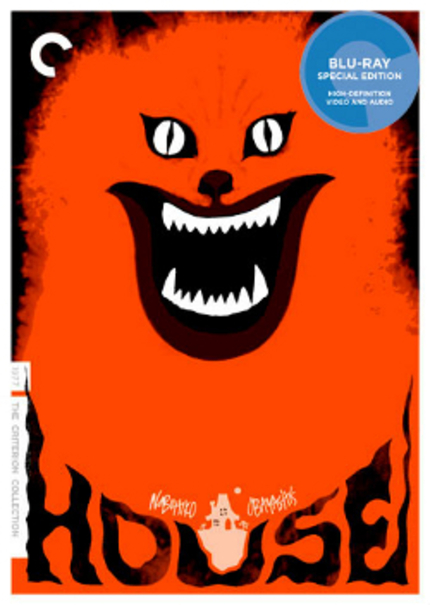Blu-Ray Review: HOUSE

Janus Films' aggressive booking and marketing of Nobuhiko Obayashi's psychedelic art-horror film House (Hausu) has quickly turned a heavily-bootlegged Japanese obscurity into a North American pop culture phenomenon. So much has been written about House in recent years that one might get the impression that there is not much to say. To the contrary, The Criterion Collection's new Blu-Ray shows there is much left to be said about House.
Nobuhiko Obayashi was itching to use his skills as a television commercial director -- he did those Charles Bronson Mandom commercials floating around the Internet -- to make a feature film. He asked his 11 year old daughter Chigumi to come up with some ideas. She came up with some wild concepts that only a little kid could dream up, including: an evil cat, a house that eats people, a finger-chopping piano, murderous futons, a bleeding clock and all other sorts of mayhem. Nobuhiko Obayashi subsequently handed these ideas to screenwriter Chiho Katsura, who came up with a story about a teenage girl named Gorgeous who takes 6 friends -- Melody, Fantasy, Prof, Kung Fu, Sweet, and Mac -- to her auntie's huge creepy house for summer vacation.
House starts off as a bubble-gum school girl fantasy. Schools out for summer; the sun is shining, rainbows penetrate the sky, and life is care-free. As the girls move from the city into the country, the film grows increasingly dark and nightmarish. Just as dreams have no continuity, House shifts moods with an intentional defiance of logic or rationality. The film is rife with visual and audio non-sequiturs. Dark serious moments are broken up with jokes or visual gags. Weird sounds intentionally pop up in the mix for no reason. The third act contains an unparalleled stretch of insane imagery that recalls a mix of Suspiria, which actually came out just a few weeks before House in 1977, and a Disney's Haunted Mansion. All means of visual trickery, including rear projection, matte paintings, slo-mo, stop-motion animation, miniatures, and video, were used to visualize Chigumi Obayashi's ideas. The soundtrack by Asei Kaboyashi and Godiego -- the same band that the music for the TV show Saiyūki aka Monkey -- matches the schizophrenic mood. The music jumps from melodic piano motifs to pop tunes to Goblin-style prog-rock weirdness
A couple of legit home video releases of House are available, including a subtitled R2 DVD from Masters of Cinema and a really old unsubbed DVD from Toho. Criterion is wisely releasing both a DVD and Blu-Ray, which gives cinephiles a previously unavailable high-def option. Indeed, the Region A encoded Blu-Ray is easily the best home video presentation of House.
The digitally restored transfer, which was sourced from a 35mm print that was struck from the original negative, played on IFC channel a few years ago. The Masters of Cinema and Toho releases use 1.55:1, but Criterion presents the film in the original 1.33:1. The Blu-Ray is full frame with black bars at left and right on 16:9 displays.
The MPEG-4 AVC video stream is encoded at a whopping 35 mbps. In comparison, the Toho R2 DVD rates an average 5.56 mpbs; DVD Beaver reports the R2 Masters of Cinema DVD streams at an average 5.76 mbps. The image is clean, vivid, and the psychedelic colors pop out the screen. Some of the optical effects look creaky -- the techniques are fairly old -- but most of the effects are hold up very well in high-def.
Sound is uncompressed Japanese mono. Bright white English subtitles are provided. The subs are perfectly readable on the main feature, but they occasionally blend in with white background colors on some of the extras.
The extras reflect a few curious choices. As usual, a nice little color essay booklet is included; Chuck Stephens provides the essay. Obayashi's 39 minute "short" non-linear experimental film Emotion (1966) incorporates many of the same visual techniques displayed in House. The best extra is a 45 minute featurette called Constructing a House interviews key players -- the director, Chigumi Obayashi, Chiho Katsura, and musician Asei Kaboyashi -- to get the full story about how the film came to be and its reception in Japan. A brief interview with Ti West, an avowed House fan, is a lot better than it initially appeared to be. He knows his stuff and talks about the film's unique qualities with precise language. This interview brings up a relevant question: where are the voices of contemporary Japanese directors or critics? They are nowhere to be found here. Criterion deserves some credit for changing things up -- there are none of the typical ruminations of Donald Ritchie or Tony Rayns --- but more varied perspectives would be welcome.







